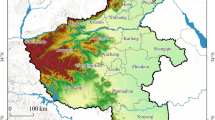Abstract
In order to investigate the effects of carbon emissions in land consolidation projects, carbon emissions generated during the five construction processes of land consolidation project, i.e., land levelling, irrigation & drainage, road construction, cropland protection & eco-environment maintenance, and village renovation, as well as the data of carbon emissions caused by regional land-use change, are analyzed from the perspectives of energy consumption and land-use change using the Intergovernmental Panel on Climate Change inventories based on the land consolidation project implemented in the Township of Jiangwucheng, Ci County, Hebei, China. The role of carbon source/sink and the associated calculating method are determined, based on which the corresponding suggestions regarding the reduction of carbon emissions in land consolidation projects are proposed with the aim of providing a general scientific reference for research on carbon emissions in land consolidation and practical low-carbon land consolidation projects. Results obtained from this work demonstrate that (1) the amount of CO\(_{2}\) emissions caused by energy consumption is 12481.549 t, and the amounts of CO\(_{2}\) emissions caused by irrigation & drainage and county road construction are 5932.980 and 4494.005 t, corresponding to CO\(_{2}\) emissions per unit investment of 1.605 t/10,000-yuan and 2.029 t/10,000-yuan, respectively, substantially higher than the values of any other sub-project; (2) land-use change caused by the implementation of this land consolidation project arouses a 1704.346 t carbon content increase of soil and vegetation in this region with the maximum carbon variations detected in cropland and grass land, exhibiting the effect of carbon sink; (3) according to the cost-benefit analysis of environmental economics, implementing this land consolidation project generates a carbon content rise equivalent to 9222.684 t carbon emission, where the carbon emissions per unit consolidation area and the carbon emissions per unit investment are 2.89 t/hm\(^{2}\) and 1.028 t/10,000-yuan, respectively.

Similar content being viewed by others
References
Houghton, R.A.: The annual net flux of carbon to the atmosphere from changes in land use 1850–1990. Tellus Ser. B. 51(2), 298–313 (1999)
Houghton, R.A.: Revised estimates of the annual net flux of carbon to the atmosphere from changes in land use and land management 1850–2000. Tellus Ser. B 55(2), 378–390 (2003)
Houghton, R.A., Hackler, J.L.: Sources and sinks of carbon from land-use change in China. Global Biogeochem. Cycles 17(2), 1034–1047 (2003)
Levy, P.E., Friend, A.D., White, A., et al.: The influence of land use change on global- scale fluxes of carbon from terrestrial ecosystems. Clim. Change 67(2), 185–209 (2004)
Intergovernmental Panel on Climate Change (IPCC). IPCC Guidelines for National Greenhouse Gas In-ventories. Institute for Global Environmental Strategies, Hayama (2006)
Lubowski, R.N., Plantinga, A.J., Stavins, R.N.: Land-use change and carbon sinks: Econometric estimation of the carbon sequestration supply function. J. Environ. Econ. Manag. 51, 135–152 (2006)
Xianjin, H., Qianqian, W., Zhigang, C., et al.: Movement of the gravity of carbon emissions per capita and analysis of causes. J. Nat. Res. 24(5), 833–841 (2009)
Qu Futian, L., Na, F.S.: Effects of land use change on carbon emissions. China Popul. Resour. Environ. 21(10), 76–83 (2011)
Yujie, S., Yuchen, Z., Peng, L.: Study on the reasonable land use evaluation under the background of low carbon. Areal Res. Dev. 30(5), 93–96 (2011)
Heyuan, Y, Cifang, W.: Carbon emission efficiency and low carbon optimization of land use: based on the perspective of energy consumption. J. Nat. Resour. 25(11), 1875–1886 (2010)
Heyuan, Y., Cifang, W., Shen, P.: Correlation degree measurement and characteristic explanation between land use structure and carbon emission from energy consumption. China Land Sci. 24(11), 4–9 (2010)
Kongqing, L., Yinrong, C., Jiarong, C.: An evaluation model for the low-carbon and intensive urban land use using analytic network process. Econ. Geogr. 33(2), 156–161 (2013)
Junfeng, Z., Anlu, Z., Jie, D.: Study on relationship of intensive land use and carbon emission-a case study of Wuhan urban agglomeration. Res. Agric. Mod. 6, 717–721 (2013)
Meng, S.: Empirical study on the effects of China’s energy consumption and carbon emissions changes. Jilin University (2010)
Liu Hongqiang, F., Siyu, J.L., et al.: Calculation methods and application of carbon dioxide emission during steel-making process. Iron Steel 51(4), 74–82 (2016)
Junxiao, W., Yuanbo, G., Song, W.: The factors influencing calculation of CO\(_{2}\) emission Chinese cement industry and the determination of its uncertainty. Acta Sci. Circumst. 36(11), 4234–4244 (2016)
Jianxuan, S., Lijie, W., Jianping, G.: Analysis of carbon emissions in PVC production by calcium carbide and coal-based ethylene methods. Coal Convers. 34(1), 74–77 (2011)
National Development and Reform Commission. 2015 China Regional Power Grid Baseline Emission Factor [EB/OL] (2016). http://cdm.ccchina.gov.cn/Detail.aspx?newsId=61599&TId=19
Suimin, L., Wenlou, L., Zefeng, S., et al.: An estimation of oil organic carbon reserves in the southern plain of Hebei Province. Geol. China 37(2), 525–529 (2010)
Acknowledgements
This work was supported by the National Natural Science Foundation of China (Grant Numbers 41401201 and 41301498); the Science and Technology Research Project of Hebei Higher School (Grant Number BJ2014021); and the Natural Science Foundation of Hebei (Grant Number D2015207008); and the Social Science Foundation of Hebei (Grant Number HB14GL052).
Author information
Authors and Affiliations
Corresponding author
Rights and permissions
About this article
Cite this article
Wu, Y., Zhou, Y., Guo, Y. et al. The energy emission computing of land consolidation from the dual perspectives clustering method. Cluster Comput 20, 979–987 (2017). https://doi.org/10.1007/s10586-017-0875-7
Received:
Revised:
Accepted:
Published:
Issue Date:
DOI: https://doi.org/10.1007/s10586-017-0875-7




